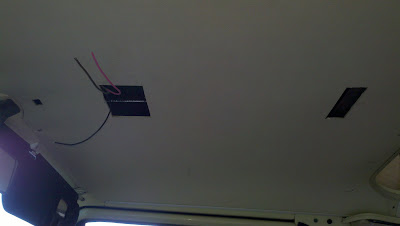
Ok, so maybe not the finale but all the Weitec springs are installed with the Bilstein shocks.
Here is the skinny on the front ones.
You do not need to have a compressor to do the front. Even though my springs are smaller than stock, unless you have particularly large springs (like those on a Syncro) or lifted springs, you 'should' be able to do the install without a compressor.
To the right, you will see the standard Vanagon front wheel suspension. Stock spring, stock type shock, fairly untouched since it came off the line. Amusing to see how much rust formed on the new calipers and rotors in a few months.
Anyway, you should be following along in your Bentley to grasp the whole process. First, I jacked up the van, supported with a jackstand (very important) and removed the wheel. The got in with my PB Blaster and squirted the shock bolts (upper and lower), upper ball joint bolts, radius arm nuts, and caliper bolts. While you are waiting for it to do its magic, slide under and do the other side. Then I started with the removal of the shock bolt on the bottom, then on top. This side was a bitch, the sleeve that rests between the upper shock mount / sleeve had seized on. It took a while to get it free so that I could reuse the shock mount again.

After removing the shock, I removed the caliper mount bolts and supported away from suspension assy. The key to this process is getting everything possible out of the way. I then removed the nut on the forward part of the radial arm. This is the part that will restrict your space to be able to remove the old and insert your new spring.
Supporting the lower control arm with a floor jack, remove the two allen head screws that hold the upper ball joint in place and push away the upper control arm. Slowly lower the jack to release pressure on the spring. Pull the spindle assy away to provide room to work and slide out the spring.
You may need to put some pressure on the lower arm to give extra space. I did it by putting a 19mm wrench on the lower ball joint nut and pushing straight down.

The insertion was much simpler than the removal as my springs were a bit shorter than the stock ones. Especially since one was broken.
Final stance numbers: front 14.5 both sides, 14.875-15 on rear. Will check again after sitting for a few days to see what settling happens, but since the rear has been in for a couple months, I am happy there is no Westy lean to adjust for as of yet.
Did both sides in about 3 hours (plus an hour screwing around with the damn shock sleeve). Even with the little man's "assistance". Kid loves this camper, and I will allow him all the time he wants to tinker.

Not really a finale. I have started accumulating all the parts to do a full rebuild to the front end. Powerflex urethane bushings, all new ball joints and such, radius rod bushings and more.
EDIT-1 March 12- The real finale will be coming up shortly. I know this is the largest draw to this blog to date and I aim to please. I have accumulated all the parts to do a FULL rebuild of the front end, but my hold up has been over a sandblaster. Once all the parts are out, I want to clean all the parts up, paint them with Imron, clean up the undercarriage on the front and reassemble it better than new. Clean cars are easier to maintain, more fun to work on, and nicer to look at.
Now that I have a new sandblaster and a compressor that can handle it, once the weather cooperates I will get to work and take many pictures. I may try to procure a set of control arms and have them ready prior to disassembly, just for expediency's sake.
EDIT - 20 April 12 - Been focusing on the paintwork prep, but have bought a parts van to help with the front suspension pieces. This way I can have the control arms pulled, sprayed and ready to go when I disassemble the Thingamajigger.
But I do have an opinion on the Weitec spring / Bilstein combo: I am going to try a Koni shock in front as I find the Bilstein too bouncy with the lowered spring.
















